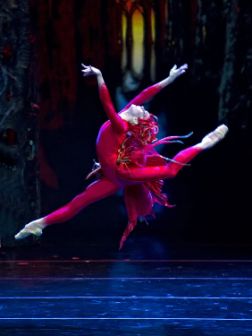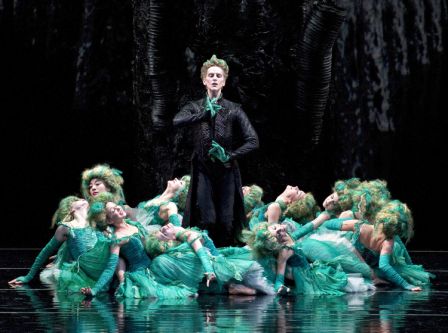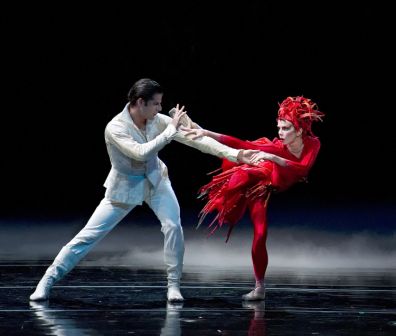I loved Ratmansky’s new Firebird at American Ballet Theatre. The controversy it has stirred up among critics and balletomanes–many are ambivalent, some downright despise it–also makes sense, given the local, Balanchine production’s regular outings.
The Firebird‘s music is alternately mystical and comically rambunctious. Stravinsky shimmers for romance and clangs for adventure. But the score has not inspired the dramatic ballets you might expect. From Fokine on, choreographers have not considered what the characters need from one another. Ivan – your average dolt of a Russian folktale hero – grabs at the Firebird for sport. He falls in love with the captive Maiden because she is there – in the monster Kaschei’s garden, where he has wandered. She is there because Kaschei has captured her. The plot goes round and round.
The genius of Alexei Ratmansky – American Ballet Theatre’s artist in residence, former Bolshoi director – is to turn the lack of dramatic imperative to his advantage. The pathos and delight of his Firebird lies in the fact that this Ivan and Maiden are not destined to fall in love; they decide to.
The ballet begins with Ivan (Marcelo Gomes) seeking romance in Simon Pastukh’s gorgeously disturbing forest of twisted metal trees. Why he thinks a post-industrial waste facility will prove a chick magnet is anyone’s guess, but it does attract firebirds, including stand-out Natalia Osipova. Gomes latches on to her.
Wary: Marcelo Gomes and Natalia Osipova. Photo courtesy of ABT by Gene Schiavone.
She surrenders like a bird in a cat’s jaws. She is lively only when pushing against him, cocking her head to get a better look. The pas de deux runs counter to many a ballet seduction, where the woman’s limpness is meant to signify her joy…..
Please click for the rest. Every click is a click for dance! If you hit a subscriber wall, you only have to register once, by giving them your email, and you receive 30 free articles per month–and no emails nagging you to subscribe.


Once the Maidens arrive, Ratmansky’s Firebird begins to soar–and keeps soaring until the curtain comes down. This choreographer is always great with groups of women–in Namouna and with The Nutcracker snowflakes, for example. He gets the pathos: the mix of camaraderie and individual invisibility. By the time the Maidens converge on the scene–with Simone Messmer’s endearing, comical Maiden in the lead–the ballet just gets funnier and funnier and more and more moving. At one point I began to laugh under my breath–like a feather were tickling my diaphragm–and didn’t stop for five minutes. Ratmansky makes you love these people–this Ivan, this Maiden and her clique, even Kaschei–and respect the forever mysterious bird, who is not, as she has never been, loveable–no more than fire is.


I can’t understand these comments. What I remember from Fokine’s magical “Firebird,” the only legitimate choreography, from my point of view, is Prince Ivan, the hands of the corps de ballet, Khastchei, so many images, and, yes, the Firebird herself. His choreography for the Firebird was, for me, the least convincing of the whole ballet, but I only know the Fonteyn/Royal Ballet video, which omits much of the choreography, sadly.
Ballets where the music and choreography are created hand-in-hand by two masters of their arts should never be tampered with. Even if you accept the idea of new choreographers stealing the music for their own “versions.” Too few people have been able to see the original for valid comparisons to be made. It is not like Shakespeare, where more-or-less faithful production are not hard to be found. In ballet, it is exceedingly rare for the original productions to be maintained, even when they are masterpieces. Nowadays, when perhaps through the miracle of YouTube, we are able to see some rare film of the Ballets Russes, we get a glimpse of an esthetic world we can only dream of, or see a watered-down version of in the great movie musicals.
If Fokine, Massine and the other great choreographers were constantly produced everywhere, then we might be able to occasionally view someone else’s attempt as a change of pace. Like movie re-makes, the new choreography is rarely as good as the original.
The real problem is the lack of effort choreographers and companies put into the music side of ballet. The biggest problem is the false notion that choreography, that dance exists without music, that it is a wholly independent art. Bullshit. Bad thinking.
Without music, dance is movement theater. On rare occasion, a brilliant choreographer can create the effect of silent music. Rarely, though.
For decades now, choreographers have simply put on records, pasted together music to suit their fancies, and produced piles of drecklich ballets. Even Balanchine is guilty.
In general, you cannot put together unrelated pieces of music in one ballet, even if they are by the same composer. No. You just cannot do that. You are diminishing the music, and thus diminishing the ballet. If you respect your art, you will respect the music. Find composers to work with, learn to work together.
Be artists, not milliners of movement. Forget Balanchine, please. He was a hugely destructive influence. Go see Massine, Fokine, Nijinska. Please.
Wow, are you for real, Baron Z? I feel as if I’ve come upon an exhumation.
I don’t know where to begin, so mainly I won’t, except to say, dance may not exist without music (a dubious assertion, but I’ll let it go), but the music very much exists without dance. The idea that there is only one legitimate response to the music–the first, you say–is as primitive as the notion that a word– say, “snow”–and its meaning are essentially linked. Forget “neige” or whatever “neige” is in Norweigan, Sanskrit, Farsi, etc.
Still, thank you for your impassioned response. And welcome to the 20th century–perhaps next year the 21st?
~) Apollinaire